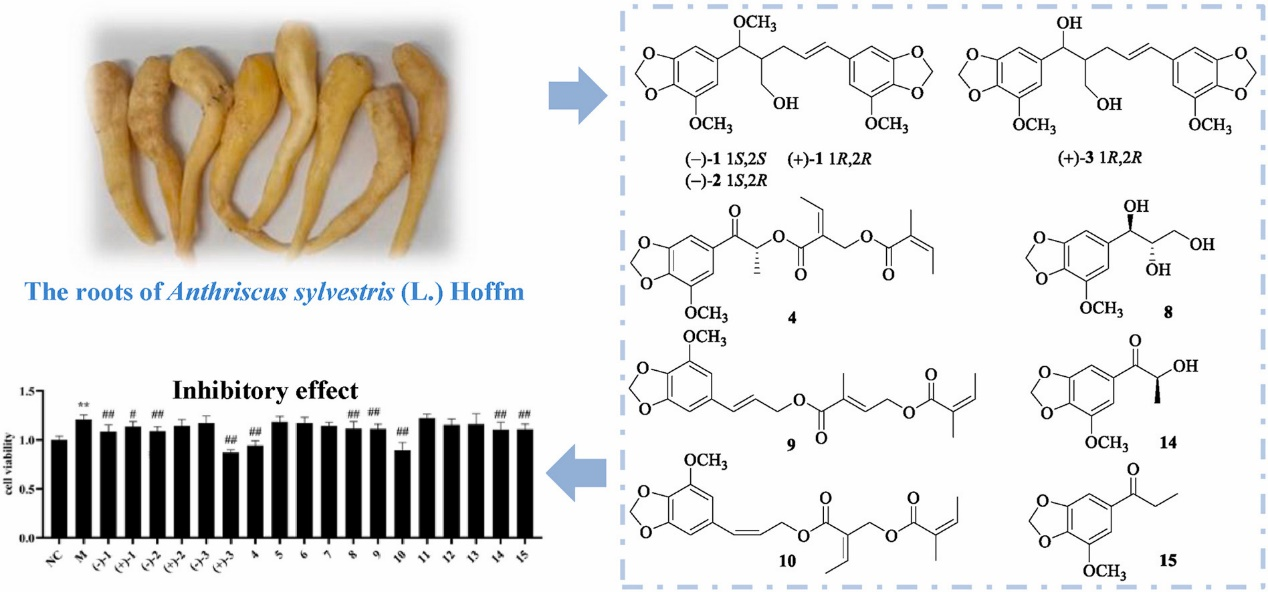Abstract
Three pairs of undescribed diarylpentanoid enantiomers (1–3) and five undescribed phenylpropanoids (4–8), along with seven known compounds, were isolated from the roots of Anthriscus sylvestris. The structures of compounds (1–8) were determined by analysis of their 1D and 2D NMR spectra, HRESIMS, and electronic circular dichroism. In addition, the inhibitory activities against hypoxia-stimulated pulmonary arterial smooth muscle cells abnormal proliferation were evaluated by MTT assay. The mRNA expression levels of Bcl-2, BAX, Caspase3, and IL-6 were detected by quantitative real-time PCR. The results showed that compounds (−)-1, (+)-1, (−)-2, (+)-3, 4, 8–10, 14, and 15 inhibited the abnormal proliferation of PASMCs by regulating the levels of apoptosis and inflammatory factors.
Introduction
Anthriscus sylvestris (L.) Hoffm is known as wild chervil or cow parsley, and belongs to the Anthriscus genus (Umbelliferae), which is mainly distributed in Asia, Europe, North America, Africa, and New Zealand (Olaru et al., 2015). Since ancient times, the roots of A. sylvestris have been used as a traditional Chinese medicine to act as antipyretic, analgesic, diuretic agent or against cough in China (Kozawa et al., 1982). Previous phytochemical studies on A. sylvestris have resulted in the isolation of lignans (Orčić et al., 2021), phenylpropanoids (Du et al., 2020), terpenoids (Bos et al., 2002), and flavonoids (Abdulmanea et al., 2012), which possess antitumour (Jeong et al., 2007; Yong et al., 2009), antioxidant (Dall'Acqua et al., 2006), and anti-inflammatory activities (Lee et al., 2018).
Pulmonary arterial hypertension (PAH) is a complication of chronic lung diseases characterized by elevated blood pressure in small pulmonary vessels, which is associated with pulmonary vascular proliferation and remodeling (Liu et al., 2014). The proliferation of pulmonary arterial smooth muscle cells (PASMCs) is a key pathophysiological component of vascular remodeling in PAH, and intervention in pivotal cellular and molecular events involved in this abnormal proliferation appears to provide a novel approach for treatment of PAH (Liu et al., 2014; Rodat et al., 2007). Previous studies have revealed that the roots of A. sylvestris exhibit therapeutic effects on lung-related diseases (An et al., 2021; Kim et al., 2019). To further study the chemical diversity and biological activities of the roots of A. sylvestris, all isolated compounds were identified and evaluated for their inhibitory effects. This paper describes the isolation, structural elucidation, and preliminary bioactivities of these compounds.
The article published in Phytochemistry Vol.216, December 2023, 113865


Post time: Nov-08-2023


